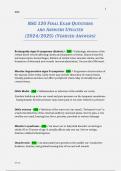1
NSG
NSG 120 FINAL EXAM QUESTIONS
AND ANSWERS UPDATED
(2024/2025) (VERIFIED ANSWERS)
Retinopathy signs & symptoms (diabetic) - ANS ✓Pathologic alteration of the
retinal blood vessels affecting clarity and sharpness of vision. Characterized by
microaneurysm, hemorrhages, dilation of retinal veins, macular edema, and the
formation of abnormal new vessels (neovascularization). Occurs after DM onset.
Macular degeneration signs & symptoms - ANS ✓Progressive deterioration of
the macula of the retina. Early onset may include distortion of central vision.
Usually painless and does not affect peripheral vision. May eventually lose all
central vision.
Otitis Media - ANS ✓inflammation or infection of the middle ear cavity.
Exudate builds up in the ear canal and puts pressure on the tympanic membrane.
Asymptomatic but the pressure may cause pain or ear ache related to pressure.
Otitis externa - ANS ✓Infection of the outer ear (ear canal); "Swimmer's ear" is
a bacterial infection of the external auditory canal and pinna. Severe pain, a red,
swollen ear canal, hearing loss, fever, pruritus. purulent or watery drainage
Ménière's syndrome - ANS ✓An inner ear or labyrinth disorder occurring in
adults 30 to 50 years of age. It usually affects only one ear. Severe vertigo,
tinnitus, unilateral hearing loss.
Otosclerosis - ANS ✓An abnormal bone growth in the middle ear. Conductive
deafness, tinnitus, and gradual hearing loss of low and soft sounds
NSG 120
, 2
NSG
Ruptured Tympanic Membrane - ANS ✓Any type of tear or injury to the
eardrum causes a breach in the integrity of the membrane. This may be the result
of pressure, force, or insult from the exterior aspect, or it may be caused by
increased pressure within the middle ear. Symptoms may include slight pain,
partial hearing loss, or discharge/bleeding from the ear
Benign Paroxysmal Positional Vertigo (BPPV) - ANS ✓usually a vestibular
system disorder. The patient complains of his/her head spinning, becoming
worse with movement of the head. They also may complain of a feeling that their
surroundings are moving.
Common Cold (signs/symptoms, treatment, prevention) - ANS ✓Viral
infection. Mucous membranes of the nose and pharynx are swollen and red.
Fever, headache, sore throat, cough. Although difficult to avoid, hand hygiene can
help with prevention. Rest and consumption of fluids to "treat".
Sinusitis (signs/symptoms, treatment, prevention) - ANS ✓Bacterial,
secondary to a cold, that has obstructed a drainage passageway.
Symptoms: pain in facial bones, congestion, fever, sore throat.
Prevention with hand hygiene, treatment with antibiotics.
Laryngotracheobronchitis (Croup) (signs/symptoms, treatment,
prevention) - ANS ✓Viral infection in toddlers. Upper respiratory congestion,
barking cough, hoarse voice, stridor. Usually recovers on its own but humidifier
may help
Influenza (signs/symptoms, treatment, prevention) - ANS ✓Viral infection
affecting upper and lower respiratory tract. Differs from the common cold
because it has a sudden, acute onset with fever, fatigue, and body aches.
Secondary problem is bacterial pneumonia.
Scarlet Fever (signs/symptoms, treatment, prevention) - ANS ✓upper
respiratory infection caused by streptococcus pyrogenes. Fever, sore throat, rash,
and "Strawberry tongue". Can generally be treated with acetaminophen.
Antihistamines reduce secretions. Secondary infection may include strep throat.
NSG 120
, 3
NSG
Pneumonia (signs/symptoms, treatment, prevention) - ANS ✓S/S:
Inflammation of the lungs: unilateral, bilateral, or all of infected lung
The larger area affected, the more severe
Adults: Cough, fever, shortness of breath at rest, chills, sweating, chest pain,
cyanosis, blood in sputum
Infant/Child: "panting" or shallow, rapid respirations
Aspiration: aspiration of liquids or material into tracheobronchial tree
Treatment:
Based on the cause of the pneumonia
Organism-specific antibiotics for bacterial pneumonia
Tetracycline drugs, erythromycin, doxycycline, sulfonamides
Mycoplasma treat with broad spectrum antibiotics
Fungal infections treat with anti-fungal
Viral infections treat with antiviral agents
Use of analgesics, oxygen therapy, bed rest, increased fluid intake, high calorie
diet, postural drainage beneficial
Prevention:
Pneumococcal vaccine
Cystic Fibrosis (S&S and Tx) - ANS ✓Inherited disorder in childhood. Defect in
exocrine glands causing abnormally thick, tenacious sputum that obstructs the
lungs. Distended abdomen, steatorrhea, failure to maintain weight and hit normal
growth milestones. Requires replacement therapy for pancreatic enzymes, a well
balanced diet, and intensive chest physiotherapy
Lung Cancer (S&S and Tx) - ANS ✓Benign is rare. 3rd most common cancer.
Obstruction of airflow by tumor growth, Inflammation stimulates a cough, and
NSG 120
, 4
NSG
usual systemic effects of cancer. Lung cancer is not always detected right away
because it is masked with predisposing factors such as smoking.
Early signs include a persistent cough, dyspnea, wheezing, detection on an x-ray,
hemoptysis, chest pain. Treatment may include chemotherapy or resection.
Aspiration (S&S and Tx) - ANS ✓Passage of fluid, food, vomit, etc. into the
trachea and lungs. Right lung is often the destination for these things. This can
lead to coughing, choking, stridor, wheezing, tachycardia, tachypnea. Easier to
prevent than treat.
Prevention... don't choke on things (:
Obstructive Sleep Apnea (S&S and Tx) - ANS ✓Pharyngeal tissues collapse
during sleep leading to periods of apnea (cessation of breathing). Usually
diagnosed when a sleeping partner notices loud snoring and intermittent gasps
for air. Related to chronic hypoxia and fatigue, Diabetes, pulmonary
hypertension, right sided CHF, Erectile Dysfunction, Depression, and Daytime
sleepiness. Treatment involves the use of a CPAP machine.
Asthma (S&S and Tx) - ANS ✓Includes period episodes of severe bronchial
obstruction in those with hypersensitive or hyper-reactive airways. May be acute
(happening once) or chronic (lifetime). Inflammation, edema, increased
secretions, contraction of smooth muscle. Cough, dyspnea, wheezing, tight chest,
pt unable to talk. Treat with avoidance of triggers, good ventilation, and
prophylactic medications.
COPD - ANS ✓A group of chronic lung diseases characterized by progressive
tissue degeneration and obstruction of lung airways. Some of these include
Emphysema, Chronic Bronchitis, and asthma
Emphysema - ANS ✓Destruction of the alveolar wall which leads to permanent
damage and permanently inflated alveolar air sacs. BARREL CHEST. Loss of
surface area for gas exchange, loss of pulmonary capillaries, and loss of elasticity.
Dyspnea, hyperventilation, anorexia (may occur), fatigue, clubbed fingers.
Treatment may include pulmonary rehab, bronchodilators, diet, breathing
techniques.
NSG 120




